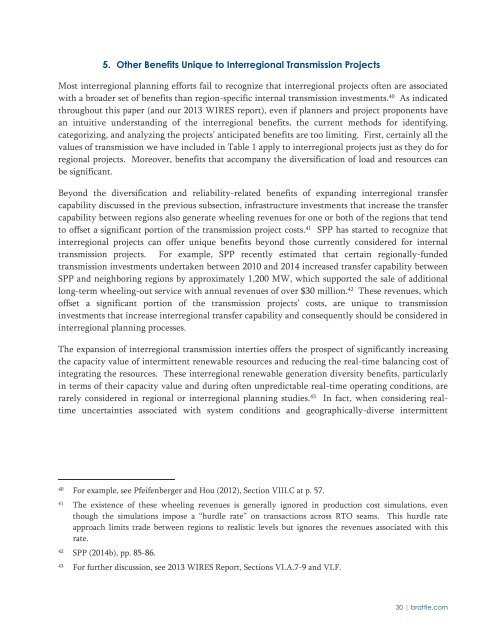THE BRATTLE GROUP
pvrbYG
pvrbYG
Create successful ePaper yourself
Turn your PDF publications into a flip-book with our unique Google optimized e-Paper software.
5. Other Benefits Unique to Interregional Transmission Projects<br />
Most interregional planning efforts fail to recognize that interregional projects often are associated<br />
with a broader set of benefits than region-specific internal transmission investments. 40 As indicated<br />
throughout this paper (and our 2013 WIRES report), even if planners and project proponents have<br />
an intuitive understanding of the interregional benefits, the current methods for identifying,<br />
categorizing, and analyzing the projects’ anticipated benefits are too limiting. First, certainly all the<br />
values of transmission we have included in Table 1 apply to interregional projects just as they do for<br />
regional projects. Moreover, benefits that accompany the diversification of load and resources can<br />
be significant.<br />
Beyond the diversification and reliability-related benefits of expanding interregional transfer<br />
capability discussed in the previous subsection, infrastructure investments that increase the transfer<br />
capability between regions also generate wheeling revenues for one or both of the regions that tend<br />
to offset a significant portion of the transmission project costs. 41 SPP has started to recognize that<br />
interregional projects can offer unique benefits beyond those currently considered for internal<br />
transmission projects. For example, SPP recently estimated that certain regionally-funded<br />
transmission investments undertaken between 2010 and 2014 increased transfer capability between<br />
SPP and neighboring regions by approximately 1,200 MW, which supported the sale of additional<br />
long-term wheeling-out service with annual revenues of over $30 million. 42 These revenues, which<br />
offset a significant portion of the transmission projects’ costs, are unique to transmission<br />
investments that increase interregional transfer capability and consequently should be considered in<br />
interregional planning processes.<br />
The expansion of interregional transmission interties offers the prospect of significantly increasing<br />
the capacity value of intermittent renewable resources and reducing the real-time balancing cost of<br />
integrating the resources. These interregional renewable generation diversity benefits, particularly<br />
in terms of their capacity value and during often unpredictable real-time operating conditions, are<br />
rarely considered in regional or interregional planning studies. 43 In fact, when considering realtime<br />
uncertainties associated with system conditions and geographically-diverse intermittent<br />
40<br />
For example, see Pfeifenberger and Hou (2012), Section VIII.C at p. 57.<br />
41<br />
The existence of these wheeling revenues is generally ignored in production cost simulations, even<br />
though the simulations impose a “hurdle rate” on transactions across RTO seams. This hurdle rate<br />
approach limits trade between regions to realistic levels but ignores the revenues associated with this<br />
rate.<br />
42<br />
SPP (2014b), pp. 85-86.<br />
43<br />
For further discussion, see 2013 WIRES Report, Sections VI.A.7-9 and VI.F.<br />
30 | brattle.com


